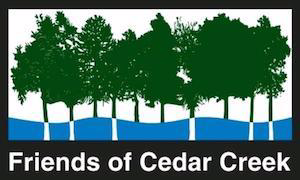Guide to Cedar Creek
Cedar Creek's Unique TopographyLarry Yoder
Cedar Creek Canyon (Heather Baker)
In Allen County’s otherwise gently rolling moraines and flat outwash plains, sluiceways and lake beds, the Cedar Creek valley’s topography is unique.
As Cedar Creek makes an abrupt turn eastward at Coldwater Road, it flows through one of Indiana’s most dramatic examples of a glacial tunnel valley. This valley extends east for about 5 miles from the tunnel’s mouth at Coldwater Road. The valley canyon averages about 1000 feet wide, and in some places, as much as 80 feet deep.
The tunnel valley formed when glacial meltwater, flowing under pressure, eroded a channel into the earth beneath the ice. When the ice disappeared, a deep ravine or canyon remained as evidence of the extensive excavation that had taken place—the “glacier’s footprint.”
In geological terms, the Cedar Creek valley is young, formed when the Erie lobe of the Wisconsin Glacier receded about 15,000 to 20,000 years ago. The valley was cut into deposits that formed the Wabash Moraine (an accumulation of soil and rocks distributed by the glacier). This rock and soil sediment washed westward from the valley into the adjacent Eel River sluiceway.
Subsequent erosion on the valley’s floor led to a “beheading” or capture of the Cedar Creek that reversed the stream’s original westward flow through the tunnel valley to its present eastward direction.
More to Explore . . .
- Environmental Geology of Allen County Indiana. N.K. Bleuer & Michael C. Moore. Department of Natural Resources Geological Survey, Bloomington, IN. Special Report 13. 1978.
- Fort Wayne, Indiana: Paleozoic and Quaternary Geology Centennial Field Guide Volume 3: North-Central Section of the Geological Society of America. Jack Sunderman. pp. 325–332. 1987.
- The Hydrology of Allen County, Indiana: A Geologic and Ground Water Atlas. Anthony Fleming. Indiana University, Indiana Geological Survey, Bloomington, IN. Special Report 57. 1994.
- Native American Place-Names Of Indiana. Michael McCafferty. University of Illinois Press, Urbana and Chicago. 2008.
- Roadside Geology of Indiana. Mark J. Camp, Graham T. Richardson. Mountain Press Publishing Company. p. 238-39. 1994.





